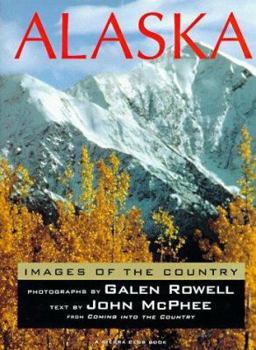Alaska: Images of the Country
Select Format
Select Condition 
Book Overview
Pairing exerpts from John McPhee's Coming Into the Country, with images by wilderness photographer Galen Rowell, this book offers a portrait of modern Alaska. This description may be from another edition of this product.
Format:Hardcover
Language:English
ISBN:0871562901
ISBN13:9780871562906
Release Date:June 1982
Publisher:Sierra Club Books
Length:145 Pages
Weight:2.35 lbs.
Dimensions:0.7" x 9.2" x 11.8"
Customer Reviews
2 ratings
Disturbing Images
Published by Thriftbooks.com User , 21 years ago
Galen Rowell was one of the great outdoor photographers and most of his books are full of spectacular pictures of mountain scenery. But if you are expecting a normal picture book about Alaska, this isn't it. Instead this is a look at a place that is full of ambiguity.The book is structured around John McPhee's book "Coming into the Country". In that book McPhee gives an insightful description of Alaska as a place, and its inhabitants. The Alaskans seem torn between preserving the wilderness and developing it and the extracts contained in this volume capture that spirit. For example, McPhee provides admiring character studies of a number of people who came to Alaska because they just didn't fit in back in the lower 48 states. Even his descriptions of travels in the wilderness have an overlay of the politics of the state, where the federal government, which once owned most of the land, is distrusted by most citizens.Rowell decided that he wanted to take McPhee's writing and illustrate it with his own pictures. The preface makes clear that McPhee didn't offer a lot of cooperation. In fact he warned Rowell not to overprint his verbal pictures with Rowell's. The text selection was made by Rowell and the pictures included are not directly related to the words but have a close connection to their spirit.As I noted, this is not any ordinary Rowell book (if there is such a thing). There are far more pictures of human beings and their artifacts then one usually finds in such a book, and I sometimes felt that the pictures were gritty and dark. At first I thought that this was a shortcoming of the photographs but then I realized that Rowell had specifically selected these pictures because he believed that they reflected the spirit of McPhee's words. Oh, there are some grand landscapes like a picture of snow-covered Mount McKinley across isolated Nugget Pond, but there is also a picture of the same snow-covered peak taken across a dark, intruding asphalt highway into the wilderness.The final pages capture the essence of this book. McPhee describes the role of the 55 gallon steel drum in the Alaskan landscape, and tells how his view has gone from considering them ugly to finding them almost blooming. Opposite these words Rowell has placed a picture of a long line of rusty drums curving sinuously out of the frame into the Arctic Ocean.This book is more than 20 years old and the McPhee book almost 40 years old. Alaska may have changed since then, although everything I've read about it recently makes me believe that the same forces are still at work out on this frontier. But for a person interested in Alaska this book provides a feeling for the place and its people that has the ring of authenticity.If you want to see Alaska as a work of art, then I would recommend Art Wolfe's recent book of photographs "Alaska". But if you want to understand how a bright place can still have a dark soul, "Images of the Country" is a good place to start.
a fantastic book about a fantastic state
Published by Thriftbooks.com User , 24 years ago
"Alaska" is one of those books that, after teh first few pages lets you forget the world around you and fly to other places. His pictures are breathtaking, and it is true : a picture sas more than a thousand words; rowell manages it to tell you more about Alaska with a couple of photographs than 100 professors could tell you. He shows the reader that there is still some pure wilderness out there and that it is worth to preserve it. rowell is someone who loves the wilderness and the beauty of nature and he makes you love it too.





